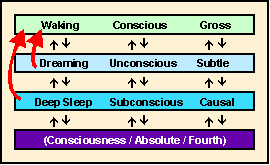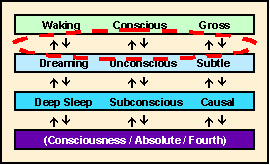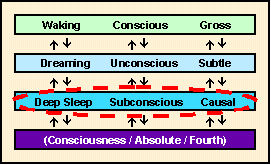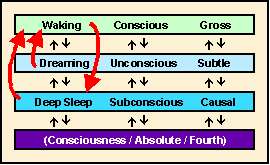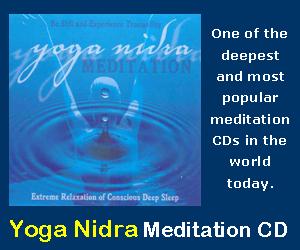![]()

It is a universally known
feature of Deep Sleep that there
are no images in the mind. If there are images, that is the
Waking or the Dreaming state, not the Deep Sleep state.
Yoga Nidra relates to conscious Deep Sleep.
("Nidra" means "Deep Sleep" not "Dreaming")
Dreaming and Not-Dreaming are NOT the same thing.
Yoga*
Nidra:
Yogic Conscious Deep Sleep
by
Swami Jnaneshvara Bharati
Homepage

This article is
available in printed and bound form.
This is especially useful for teachers conducting
classes, seminars, or workshops on Yoga Nidra.
(more info
about booklet)
Advanced Yoga Nidra: The form of Yoga Nidra being described in this article can be called Advanced Yoga Nidra. In recent years Yoga Nidra has been distorted in ways similar to Yoga itself. Unfortunately, almost any guided practice that brings a modicum of relaxation is now called Yoga Nidra. Therefore, it is now virtually essential that we use another term, such as Authentic Yoga Nidra, Traditional Yoga Nidra, or Advanced Yoga Nidra. I've opted for the term Advanced Yoga Nidra in this article.
 Yoga Nidra brings
an
incredible calmness, quietness and clarity. Yoga
Nidra is one of the deepest of all meditations, leading awareness through many levels of mental
process to a state of supreme stillness and insight. The descriptions in
the article below can be difficult to understand. With patient and
thorough reading, the understanding is well worth the effort, allowing
you to see the profound depth of Yoga Nidra, which is far beyond just
relaxation. It is said that a picture is worth a thousand words.
Sometimes it takes thousands of words to get the inner "aha" of the
meaning. Most important of all, it is the persistent practice that
brings the real joy of the practice of Yoga Nidra, as with all useful
practices in life and Yoga.
Yoga Nidra brings
an
incredible calmness, quietness and clarity. Yoga
Nidra is one of the deepest of all meditations, leading awareness through many levels of mental
process to a state of supreme stillness and insight. The descriptions in
the article below can be difficult to understand. With patient and
thorough reading, the understanding is well worth the effort, allowing
you to see the profound depth of Yoga Nidra, which is far beyond just
relaxation. It is said that a picture is worth a thousand words.
Sometimes it takes thousands of words to get the inner "aha" of the
meaning. Most important of all, it is the persistent practice that
brings the real joy of the practice of Yoga Nidra, as with all useful
practices in life and Yoga.
Yoga Nidra means Yogic Sleep. It is a state of conscious Deep Sleep. In Meditation, you remain in the Waking state of consciousness, and gently focus the mind, while allowing thought patterns, emotions, sensations, and images to arise and go on. However, in Yoga Nidra, you leave the Waking state, go past the Dreaming state, and go to Deep Sleep, yet remain awake. While Yoga Nidra is a state that is very relaxing, it is also used by Yogis to purify the Samskaras, the deep impressions that are the driving force behind Karma (See Karma article).
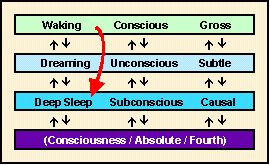
(Yoga Nidra practice methods are linked below)
Yoga Nidra has been known for thousands of
years by the sages and yogis. Of the three states of consciousness of
Waking, Dreaming and Deep Sleep, as expounded in the Upanishads,
particularly the Mandukya Upanishad,
Yoga Nidra refers to the conscious awareness of the Deep Sleep state,
referred to as prajna in Mandukya Upanishad. This is the third of the
four levels of consciousness of AUM mantra,
relating to the state represented by the M of
AUM. The four states are Waking, Dreaming, sleep, and turiya, the
fourth state. The state of Yoga Nidra, conscious Deep Sleep, is beyond
or subtler than the imagery and mental process of the Waking and
Dreaming states. As a state of conscious Deep Sleep, Yoga Nidra is a
universal principle, and is not the exclusive domain of any more recent
teachers or traditions.
|
In Yoga Nidra, you leave the Waking state, |
Contents of this web
page:
Yoga Nidra and Meditation
How consciousness recedes
Not Yoga Nidra
Brain waves are at Delta
Parachuting and Yoga Nidra
Purifying samskaras, deep habit patterns
Like the backdrop of a stage
Emptying process
Destination, not the journey
Chakras and Yoga Nidra
Tantra and the three levels
Methods are many, and simple
Methods of practicing Yoga Nidra
Yoga Nidra begins to come naturally
See also these articles:
5 Yoga Nidra method 1
2 3
4 5
OM and the Seven Levels of Consciousness
4 Levels and 3 Domains of Consciousness
Relaxation methods before meditation
|
Distortion of Yoga
Nidra |
|
The distortion of the very high practice of Yoga Nidra is so thorough in the world these days that it seems necessary to make very bright titles just to have the point noticed. Throughout this article (and others linked on this page) you will find explanations that there are THREE levels of consciousness: Waking, Dreaming, and Deep Sleep (plus the "fourth" which is the transcendent state known as Turiya). Yoga Nidra is conscious DEEP SLEEP and Deep Sleep is NOT conscious Dreaming. Yoga Nidra is also NOT the transition between Waking and Dreaming. Those are states to explore, but they are NOT Deep Sleep; if it did have dreams, that would be called Dreaming, and would NOT be called Deep Sleep. It is utterly obvious that Deep Sleep does NOT have Dreams to explore. It should be self-evident that Dreaming and Not-Dreaming (i.e., Deep Sleep) are two different things. However, books, articles, and CDs keep telling people that Yoga Nidra is a state of Dreaming, or transitioning into Dreaming from Waking. This is just not true. Throughout the ancient writings of the yogis, sages, and rishis there are explanations of these three states of consciousness. Please don't just take my word for it. Read the ancient writings, including Vedas, Upanishads, Bhagavad Gita, and others. You will find these states talked about over and over, and over again. Many people are now practicing all sorts of guided imageries in the name of Yoga Nidra so that they can make money, have better sex, or manipulate other people. There are CDs out which say Yoga Nidra is for "this or that" named disease or other specific desire-based purpose. Yoga Nidra has been made to sound like "The Law of Attraction," whereby you fulfill your desires through meditative techniques. Yoga Nidra was taught by the ancient sages for the purpose of exploring the deep impressions or samskaras, which drive our actions or karma. They taught this so that sincere seekers can purify the deeper aspect of the mind-field, which is accessed in the formless state of conscious Deep Sleep. If I try to explain the whole process here in this paragraph, I would have to condense the whole article here, which can't be done. You must do this exploration yourself. Read the article. Read the other articles. Read the texts mentioned above. I'm not writing this here just to complain about other people. The fact is, that Yoga Nidra is a profoundly useful and deep practice for enlightenment at this highest level of that word (enlightenment). The term "Yoga Nidra" has become so watered-down, so distorted that sincere seekers are not likely to see the extremely high value of authentic Yoga Nidra. If you read this, research this yourself, and then do the practices, you'll discover for yourself the very high value of authentic, traditional Yoga Nidra. I know that all of this can sound like a "sales pitch." Well, we're stuck with that. I'm writing this here so that possibly some few sincere people will move forward with authentic Yoga Nidra. There are a small handful of people out there who can talk to you about this, and guide you. I'm not going to recommend any specific names of people, however. Just explore sincerely; you'll find your way to the real thing of Yoga Nidra. While you are here, reading this part of the article, please read carefully the rest of the article, as well as some of the other articles about these three levels of consciousness (levels articles), particularly the third level, which is the domain of Deep Sleep. I know it can be a difficult read, but there's great value in understanding these levels of consciousness and how Yoga Nidra is used as a tool for higher experience. |
|
Yoga Nidra is
NOT the
Dreaming state. |
Meditation: Imagine that you are in the WAKING state, with all of its distractions of mind. You systematically do this and that with directing your attention. You are practicing concentration and letting go, leading you towards meditation. The thoughts and pictures of the DREAMING state start to come to the surface, even though you are still in the WAKING state. Gradually, the distractions fade away, your mind becomes focused, and you are having a nice meditation. You are deeply relaxed. You are still in the WAKING state of consciousness, which is the nature of meditation.
Yoga Nidra: Now, imagine that at some point you DROP or FALL or EMPTY (or
other such words) into the STATE of DEEP SLEEP, much like you would
normally do at bedtime (when not Dreaming). However, this time, you fell all the way THROUGH
the Dreaming state, and came to rest in the DEEP SLEEP state, though,
paradoxically, you remained aware and alert. This is
the level UNDERNEATH both the WAKING and DREAMING states, and all of the
thoughts and impressions that go along with those two states. Now you are in
the STATE of CONSCIOUS DEEP SLEEP. This state is the state of YOGA
NIDRA (Yoga Nidra refers to a state of consciousness, not just the
methods that lead you there).
Nidra means sleep (not Dreaming), and Yoga means union,
where all of those other thoughts and impressions have receded back into the
unified field from which they arose.
|
Swami Rama
describes "sleepless sleep" "One of the popular terms arising from exploration into the mind is alpha wave. Again, the Swami points out a common misconception and says emphatically, 'Alpha and meditation are not the same. Alpha is created by relaxation. It is not a high state. Once, when I hooked my German Shepard dog to the biofeedback machine, he created 75 percent alpha.'" |
Yoga Nidra - Conscious Deep Sleep:
Companions to the higher goal: This is not yet the higher goal of sadhana (spiritual practices), which is to experience consciousness itself, independent of any grosser false identification, etc. (one might call this purusha, atman, or the experience of the state of turiya, the fourth, but that's a different thing, which is just beyond the level of conscious Deep Sleep, the goal of Yoga Nidra). However, Meditation and Yoga Nidra work together, as companion practices, in preparing one for such higher experience.
See also these articles on the Levels of Consciousness:
OM and the Seven Levels of Consciousness
4 Levels and 3 Domains of Consciousness
Mandukya Upanishad
top
Yoga Nidra and
Yoga Meditation are Companions
|
|
In Meditation, you remain in the Waking state of consciousness, and gradually allow the layers of the unconscious and subconscious to come forward, expanding the Waking state with one-pointed concentration and non-attachment to the streams of impressions flowing in the field of mind. |
|
|
In Yoga Nidra, you leave the Waking state of consciousness, and go to the Deep Sleep state of consciousness, yet, paradoxically, remain fully awake. It is an extremely relaxing state in which samskaras of attachment and aversion, the driving force behind karma, are attenuated in strength. |
|
|
Reverie that is experienced between the Waking and Dreaming states, such as when you sometimes wake up in the morning with a pleasant half-here and half-there feeling, is not Yoga Nidra. This reverie is often the goal of relaxation and visualization exercises, but Yoga Nidra is far deeper. |
|
|
Yoga Nidra brings access to the to latent, or subconscious level of mind, that is underneath even the processing, fantasizing, imaging level of mind. It is the doorway to the causal level of reality, out of which springs the subtle, psychic, astral plane of reality, which in turn brings forth the gross level. |
|
|
Meditation and Yoga Nidra work together, as companion practices, through which you purify the deepest levels of the mind, and expand the conscious state to include what was previously unconscious. Finally, the expansion includes the realization of the pure consciousness that permeates all of the levels. |
See also these articles on the Levels of Consciousness:
OM and the Seven Levels of Consciousness
4 Levels and 3 Domains of Consciousness
Mandukya Upanishad
|
Yoga Nidra is a state of consciousness, |
top
Consciousness recedes in Yoga Nidra
 Waking AUM |
Waking State: In the Waking state of consciousness, all three levels are active and being used. The Conscious mind is obviously being used. The Unconscious mind is also processing, though typically out of view, much like the active microprocessor of a computer (during Meditation, this comes into view). The Subconscious is also active, in that it its data is available when needed, much like the data on the hard disk of a computer. [Note that sometimes people reverse the names for the Unconscious and Subconscious. The choice of words in not important; the meaning behind them is what counts.] |
 Dreaming U of AUM |
Dreaming State: In the Dreaming state of consciousness, the level we call Conscious functioning has receded back into the field of mind from which it arose. Only the Unconscious processing is still there, along with the storage source of the Subconscious. The impressions from the Subconscious stir and become part of the dream process that is going on in the Unconscious level of mind. |
 Deep Sleep M of AUM |
Deep Sleep: In the Deep Sleep state of consciousness, both the Conscious and Unconscious levels have receded back into the field of mind from which they arose, where memories are stored. Only the Subconscious level is still active. At this Subconscious level the memories are in a formless form, and there are therefore no pictures or images as in the dream state. Rather, this is the level that gives birth to those images. At this level there is also no playing out of thoughts and actions in the Conscious state either. This deep stillness is the domain of Yoga Nidra, when experienced consciously rather than inertly, as in typical sleep. |
Receding process: The significance of this receding process cannot be overstated. It has become very common in modern Yoga circles to think that Yoga Nidra is merely another terminology for relaxation exercises. This is not the case. Almost all relaxation exercises operate when one is in the Waking State or in the reverie between Waking and Dreaming. Some modern practitioners consciously dream, a process which has become known as Lucid Dreaming. While this may be a useful exercise as a Meditation exercise, particularly if used to cultivate non-attachment (vairagya), this too is not Yoga Nidra. (Non-attachment or vairagya is one of the two core principles of Yoga. See Yoga Sutras 1.12-1.16)
Conscious Deep Sleep: To repeat, Yoga Nidra is the state of conscious Deep Sleep. It is beyond, or deeper than these other practices, however useful they may be.
Yoga Nidra - Conscious Deep Sleep:
Compatible, not contradictory: It is easy to fall into the trap of thinking that because the state of consciousness of Yoga Nidra is beyond or deeper (see above) than that of some other practices, this also necessarily means better. One might then seek and do what is perceived to be the better practice, avoiding what is perceived to be the lesser practice. Regardless of what names or terms one uses, such as Yoga Nidra, Dhyana (meditation), or Smriti (mindfulness), the practices with the three levels of Waking, Dreaming, and Deep Sleep states of consciousness are compatible, not contradictory. For the Yogi, practices are done with all three levels, regardless of what he or she might call those levels and the methods of practice. This would still be true if the name Yoga Nidra had never been used by anybody for any practice or state of consciousness.
-
The Yogi consciously explores the Waking state.
-
The Yogi consciously explores the Dreaming state.
-
The Yogi consciously explores the Sleeping state.
-
The Yogi seeks to experience all three collectively.
-
The Yogi seeks to experience the Absolute beyond all three.
Formless thoughts: To understand Yoga Nidra, it is imperative to understand that thoughts are in a formless form. There are literally no pictures and no words (as there are in the Waking and Dreaming states). There is no visual awareness of any form whatsoever, including the physical aspects of your own body, or of any dream sequence. Yet, there is a truer, deeper knowledge than any of the knowledge that is of pictures and words. This level has been called the infinite storehouse or knowledge, or the infinite library (Deep Sleep, Prajna).
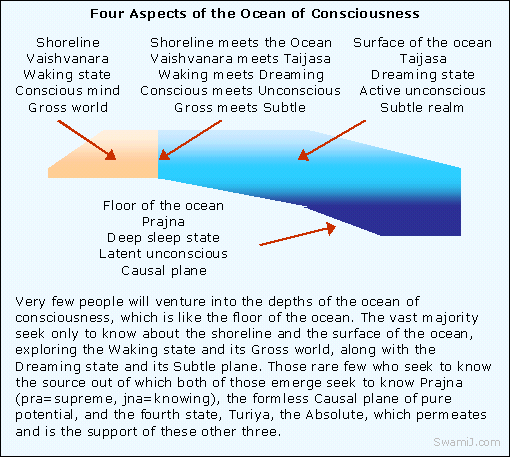
Birth of dreams: While there are no pictures at this level, attention may drift slightly outward (thus, starting to leave Yoga Nidra), through the transition stage between the Deep Sleep state and the Dreaming state. Here, the birth of images leading to dream sequences and mental processing is experienced. In Yoga Meditation science, this transition stage is called Aladani, somewhat like the story of Aladin's lamp, where the genie who was in latent form (like in Deep Sleep) goes through a transition stage of being like a wispy cloud before taking the human like form (first in the Dreaming or subtle level, and then in the Waking or gross level).
Beyond archetypes: Some schools of psychology refer to deep impressions of archetypes. However, these archetypes are referred to as having form. In the context of these archetypes, Yoga Nidra is touching the causal level that is prior to, or underneath the archetypes. It is the seed or bija level out of which the archetypes and subsequent dramas arise.
Attenuating Karma: It is because of the access to the seed or bija level that one is able to directly attenuate the samskaras, or deep impressions that drive karma, or actions.
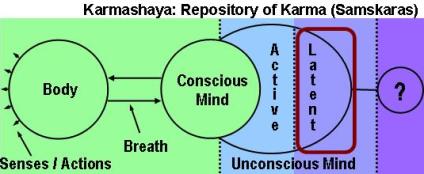
Consciousness is there 24-hours: Another way to view this process is that the consciousness at the subtler level is existent 24-hours per day. Sometimes that consciousness comes outward, expressing into the subtle, psychic, or astral level, which we commonly know as Dreaming state. At other times consciousness comes even further outward, expressing into the gross, external world through the physical body. Viewed this way, it is also easier to see how it is that the sages have said that death, Deep Sleep, and samadhi are very similar, or related like siblings.
See also these articles on the
Levels of Consciousness:
OM and the Seven Levels of Consciousness
4 Levels and 3 Domains of Consciousness
Mandukya Upanishad
|
It is a universally known
feature of Deep Sleep that there |
top
NOT Yoga Nidra
The depth of Yoga Nidra has become almost lost in recent years, as has happened with Yoga in general. Here are a few points that should help to clarify the nature of Yoga Nidra.
Not merely relaxation: It has become popular to use the term Yoga Nidra for any method that might help induce relaxation. Yoga Nidra is not mere relaxation, as very useful as relaxation exercises might be. Yoga Nidra is a specific state of consciousness, which has to do with the conscious experience of dreamless, Deep Sleep. This may seem unimportant, but if one does not discern the difference between relaxation and Yoga Nidra, the greater depth of Yoga Nidra might be completely missed. Better that one see the difference, enjoy relaxation for its own value, and then pursue the depths of Yoga Nidra when he or she is ready for this deeper practice.
Not guided imagery: If one is in the process of guided imagery, that is not Yoga Nidra. Guided imagery may be a very useful practice, and may be used as preparation leading up to Yoga Nidra, but it is not, itself, Yoga Nidra. In the depth of Yoga Nidra, the aspects of mind used for visualizing have receded, as described in the last section.
|
Guided imagery is not, itself, Yoga Nidra. |
Not affirmations or autosuggestion: Yoga Nidra is also not a practice of autosuggestion or verbal affirmations, whether affirming desired personal qualities or worldly objects that are desired. It is also not a process of verbally affirming that you are in Yoga Nidra. If you are still in such a conscious level that you are still making oral affirmations of any kind, then you are definitely not in the subtle state of Yoga Nidra. In such a case, the conscious, Waking state mind has not yet receded into the cause from which it arose.
Not the law of attraction: There is a popular movement sometimes referred to as "the law of attraction" whereby various visualizations or intents are programmed into the mind so as to manifest worldly gains such as money, new cars, or relationships. This kind of "sankalpa" or "intention" is now being used in alignment with Yoga Nidra. Some of the so-called teachers of these new "Yoga Nidra" techniques are charging large amounts of money to help people learn, in turn, to manifest the same. The sages have used this deep state of consciousness as a means of burning up desires so that they are transcended, not of affirming them so they are brought into being. The process has been effectively reversed virtually 180 degrees.
Not music: Yoga Nidra is also not music, as relaxing as music might be to the conscious mind. It is not that music is a bad thing to experience. It might be very pleasant, but it is simply not Yoga Nidra. No amount of pretending that it is will make it so. Yoga Nidra is the experience of conscious Deep Sleep (Prajna), and that does not occur while you are listening to music.
NOT Yoga Nidra: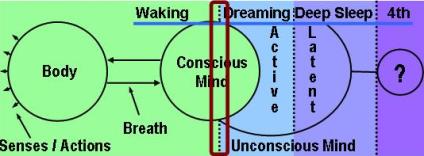
Not "alpha" or reverie: Between the Waking and Dreaming states there is a transition stage that is often called "reverie." We have virtually all experienced this relaxing, intriguing, insightful and useful state from time to time in the early morning transition as we awaken from sleep. This stage of awareness is often cultivated in relaxation training, and correlates with alpha brain waves. However useful and pleasant this may be, it is, however, NOT the stage of Deep Sleep, which is characteristic of true Yoga Nidra. Unfortunately, it has become common to use the term "Yoga Nidra" for any type of relaxation.
NOT Yoga Nidra:
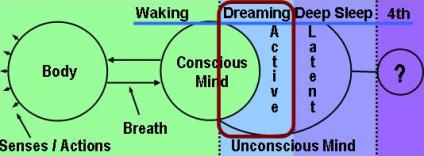
Not visualizing or Dreaming: The state of conscious Deep Sleep is a formless state where there are no pictures or words. Exploring the images and pictures of the mind field is a very useful, if not essential part of meditation. However, one of the unique features of Yoga Nidra is that it is experienced beyond these gross and subtle levels of mental process. It is a sometimes exasperating thing to have to keep explaining, but it is a universally known feature of Deep Sleep that there are no images. If there are images, that is Dreaming state, NOT Deep Sleep state. Yoga Nidra relates to conscious Deep Sleep. To understand this is very difficult for modern students because of the increasing number of articles, books, seminars and lectures that incorrectly claim that Yoga Nidra is about exploring these images. Again, those are useful processes, but by failing to understand the depth of Yoga Nidra, that depth will never be experienced. It is imperative to understand that Dreaming and Not-Dreaming (Deep Sleep) are two different processes or levels of consciousness. Some phases of meditation deal with those Dreaming level images, but Yoga Nidra relates to conscious Deep Sleep.
Not new: Yoga Nidra is an ancient most, universal process that has neither been invented nor rediscovered in recent years, as is claimed by some. This practice has been known to the sages of the Himalayas for a very long time. With some reflection on the nature of Yoga Nidra as conscious Deep Sleep (Prajna), it is self evident that this is a universal process. These levels of consciousness are addressed throughout the Upanishads, and particularly the Mandukya Upanishad.
Not a "brand name" practice: Many of the modern so-called "styles" of Yoga have a man's name in front of it, as if that man had invented Yoga. Sadly, the same thing is now happening with Yoga Nidra as well, with a person's name being put in front of the words "Yoga Nidra." The egotism and arrogance of modern so-called teachers knows no limits.
Not trademarked: When you come to see that Yoga Nidra refers to conscious deep sleep, the notion of trade marking Yoga Nidra is seen as absurd. How does a yogi sleep? Consciously. That is Yoga Nidra. How can anybody be so confused as to think you can trademark "sleep?" It seems so very unlikely, yet this is what is happening in our modern world. Only the most dedicated of practitioners will see past this play of egos so as to see and experience the universal experience of conscious deep sleep, or Yoga Nidra.

Yoga Nidra means Yogic Sleep. It is a state of conscious Deep Sleep. In Meditation, you remain in the Waking state of consciousness, and gently focus the mind, while allowing thought patterns, emotions, sensations, and images to arise and go on. However, in Yoga Nidra, you leave the Waking state, go past the Dreaming state, and go to Deep Sleep, yet remain awake.
Depth comes in time: What if you are practicing Yoga Nidra, but not yet attaining the state of Yoga Nidra? The practices leading up to Yoga Nidra are very useful. It is good to enjoy that relaxation and training of the mind. At some point, the practice deepens, maybe just for a moment, like a flash, when one experiences the depth of Yoga Nidra. It may come soon, or it may come later, but it will definitely come with patience and practice.
top
Brain waves are at Delta
Correlation with brain waves: While the goal of Yoga Nidra is spiritual insight and experience, not just to change the physical brain activity, there is some correlation with the brain wave patterns, as is summarized in the following:
| Name
of Level |
Frequency
in hertz / cycles per second |
Description |
| Beta | 14-30 | Typical level of daily mental activity, alert, active. It is also the level of activity associated with tension or stress. |
| Alpha | 8-13 | Relaxed, passive attention, reverie, often considered the goal of relaxation exercises. While this is a very relaxing state, and useful to be practiced, it is sometimes incorrectly thought to be the goal of Yoga Nidra. |
| Theta | 4-7 | Normally considered to be unconscious, possibly drowsy, or half-asleep. This level is also sometimes incorrectly considered to be the level of Yoga Nidra, where there is still the experience of images and streams of thoughts. |
| Delta | .5-3.5 | Considered to be unconscious, dreamless, Deep Sleep (Prajna). In Yoga Nidra, the brain waves are at this level, as the practitioner is in conscious Deep Sleep, beyond the activity experienced at the other levels. |
Relaxation may come first: When first practicing Yoga Nidra, there is a good chance that one might not experience Yoga Nidra itself. The practices might be very relaxing, with brain waves slowing from Beta to Alpha or Theta, but not slowing to the Delta level. Or, the other possibility that often happens initially, is that one falls asleep into the Delta level, losing conscious awareness, and thus not experiencing true Yoga Nidra.
Be patient: It is important to be very patient over time in practicing Yoga Nidra. The relaxation that comes with the Alpha and Theta levels can be extremely useful for mental, emotional, and physical health. It is not bad that one does not initially experience the depth of Yoga Nidra by consciously entering Deep Sleep and Delta. These relaxing experiences are a very nice part of life, and also prepare one for the later experience of the depth of Yoga Nidra.
Delta brainwaves, not Alpha: There has been some degree of confusion circulating about Yoga Nidra and brain waves. Possibly due to the fact that many experience only the Alpha level of brain waves initially, many teach that Alpha is the goal of Yoga Nidra. While the Alpha or Theta levels can be very useful steps along the way, the ultimate goal of Yoga Nidra is the experience of conscious Deep Sleep (Prajna), which correlates with Delta brain waves (True Yoga Nidra practice ultimately leads to awareness beyond any level of physical brain functioning).
|
Yoga Nidra means Yogic Sleep,
Yoga Nidra means Yogic Sleep,
Yoga Nidra means Yogic Sleep, |
Yogic Sleep, not Yogic Dreaming: Remember, the aspirant wants to reach Yoga Nidra, conscious Deep Sleep, so that the samskaras, which are the driving force behind karma, can be purified in their latent, formless form. And this process happens beyond, or underneath all of the activity in the Waking and Dreaming states of mind. Yoga Nidra means Yogic Sleep, not Yogic Dreaming.
top
Yoga Nidra and parachuting
State of consciousness versus methods: The methods used for Yoga Nidra are for training the mind to focus, to go inward, subtler and subtler, until finally, attention dives off into stillness and objectless-ness. The methods themselves are not Yoga Nidra. They lead up to Yoga Nidra. Yoga Nidra is a state of consciousness, not the methods that lead you there. This is a very tricky point to understand. It takes a bit of reflection to grasp. (Then it requires direct experience.)
![]() Methods are
preparation: Think of parachuting.
You get into an airplane. The airplane takes off. It climbs up to its
altitude. The pilot positions the airplane in just the right place, and
then slows down. Then, finally, you jump out of the airplane and start
to parachute. None of the steps leading up to that were themselves
parachuting, nor is the airplane itself really related to parachuting
directly. The airplane and the actions of taking off, climbing, and
moving here and there were only preparation for the moment where one can
do the part called parachuting.
Methods are
preparation: Think of parachuting.
You get into an airplane. The airplane takes off. It climbs up to its
altitude. The pilot positions the airplane in just the right place, and
then slows down. Then, finally, you jump out of the airplane and start
to parachute. None of the steps leading up to that were themselves
parachuting, nor is the airplane itself really related to parachuting
directly. The airplane and the actions of taking off, climbing, and
moving here and there were only preparation for the moment where one can
do the part called parachuting.
Variety of methods: In addition, there are different types and sizes of airplanes from which one could parachute. One could also parachute off of a cliff, a tall building, or a high bridge. Each of these are methods of bringing you to the point of parachuting. The same is true of the various methods of bringing you to the point of jumping off into the state of Yoga Nidra.
Jumping off: Entering Yoga Nidra is like jumping out of the airplane. There are many methods one can do to train the mind, to move the attention here and there, so that you can then jump out of the Waking and Dreaming states of consciousness into the fully conscious experience of Deep Sleep (Prajna). That is the experience of Yoga Nidra.
|
Yoga Nidra is beyond any creative visualization |
Seek the depth beyond imagery: There is a reason that it is so important to know that Yoga Nidra is a state rather than the methods. It is very easy to practice the techniques, but to incorrectly think that the goal is merely to relax through creative visualization. Creative visualization alone might be a useful practice, but by staying in those shallow waters, the deeper value of Yoga Nidra will be missed. One can practice visualization exercises for many years, and not be aware of the depth of Yoga Nidra. Remember the parachute metaphor, and that while creative visualizations might be useful in the practice leading up to Yoga Nidra, the Yoga Nidra itself comes by going beyond all of the imagery.
Emptying: By being aware of the differences in the levels of practice, one can consciously work on reaching the end of the practice, the point where it is time to jump out of the plane, into the emptying practice that is Yoga Nidra. This emptying process is further described in a later section of this article.
top
Purifying
samskaras,
the deep habit patterns
Examining: While Yoga Nidra is very relaxing, it is also an extremely useful state for spiritual practices. The yogis use Yoga Nidra to examine thought patterns in their latent, non-active form.
|
Yogis use Yoga Nidra |
Samskaras: This level of consciousness is the place where thoughts, emotions, images, and sensations go when they recede from their actions in the Waking and Dreaming states. These formless forms, or deep habit patterns are called samskaras, which are the driving force of actions, or karma.
Reducing deep habits: Thus, Yoga Nidra is a tool for examining, attenuating, and eliminating habit patterns or samskaras, which are not useful. Habitual negative actions, normally arising from these deep impressions can thus be reduced and eliminated through the practice of Yoga Nidra.
Undistracted by the formless: In the Waking state, thought patterns can be troubling. In the Dreaming state, they can form trains of thoughts that seem to drag you around. However, imagine that you could observe your thought patterns when they were not active, when they were in a latent, sleeping form, while you were awake. Then they would not disturb or distract you. This is what happens in Yoga Nidra. The paradox is that while they are not in active form, they are still there. This can be frustrating to try to conceptualize, but this is as close as we can get, to just say they are in a formless form.
Subtle thoughts with little charge: Imagine a photo on the screen of your computer. It might be a picture you find pleasing or offensive. However, imagine that you saw a print of the binary numbers, all of the zeros and ones, that mathematically formed those pictures in the memory of the hard disk. There would be no reaction whatsoever. There would just be a bunch of numbers, without any emotional charge to them. This is what happens when witnessing samskaras (deep impressions that drive karma, or actions) while you are in Yoga Nidra. There may be subtle traces of emotions, but they are very, very subtle, and do not seem to have the charge of active desires, wants, wishes, dislikes, or aversions.
Transformation of samskaras: By witnessing the samskaras in the state of Yoga Nidra, a certain transformation happens. They start to lose their coloring of attraction and aversion. They start to weaken, and are less and less able to later control our thoughts and actions. In this way, we use Yoga Nidra to reduce or soften the impact of our samskaras that play out as karma.
Who I am: Through Yoga Nidra, there is an ever increasing awareness that, "Who I am is different from my thoughts!" In Yoga Nidra, you experience consciousness underneath, or prior to all of the active mental process, both conscious and that which is normally unconscious. Being awake in this place, underneath or behind the thinking process can seem quite strange, bewildering at first. Gradually, it brings increasing peace of mind and insight about the nature of who we truly are.
Doorway beyond: In Yoga Nidra one touches the doorway to the awareness that still operates beyond all of the levels of mind, that leads to realization of the center of consciousness, or Self.
It comes in time: Once again, you may or may not reach the state of Yoga Nidra in the beginning. It does not matter. The deeper experience of Yoga Nidra may come soon, or it may come later, but it will definitely come with practice. In any case, you will surely find Yoga Nidra to be a very relaxing part of your life.
top
Yoga Nidra is like
the backdrop of a stage
![]() Reverie:
Imagine that you are sitting in the audience of a live theater. The curtain
is closed, such that you cannot see the set of the play. This is like being
in the Waking state. The curtain forms that reverie state between Waking and
Dreaming. While you may have left the noisiness of the busy city street, you
are still in the Waking state when sitting in the theater with the curtain
still closed. This is like coming into some quiet physical place where you
intend to do your practices, a place such as your private Meditation room or
a Yoga classroom. (Sitting in the theater, off the street, resting in a
pleasant state is somewhat like the many relaxation practices people do, but
it is not true Meditation, which permeates the subtler states. Nor is it
Yoga Nidra.)
Reverie:
Imagine that you are sitting in the audience of a live theater. The curtain
is closed, such that you cannot see the set of the play. This is like being
in the Waking state. The curtain forms that reverie state between Waking and
Dreaming. While you may have left the noisiness of the busy city street, you
are still in the Waking state when sitting in the theater with the curtain
still closed. This is like coming into some quiet physical place where you
intend to do your practices, a place such as your private Meditation room or
a Yoga classroom. (Sitting in the theater, off the street, resting in a
pleasant state is somewhat like the many relaxation practices people do, but
it is not true Meditation, which permeates the subtler states. Nor is it
Yoga Nidra.)
A halfway step: Gradually the curtain opens, and you see the objects on the set of the play and the actors. This is like viewing the Dreaming state of consciousness, the unconscious mind. This is a stance of Meditation, where you stay in the Waking state, allow the veil to open, and the unconscious comes forward, while staying focused. However, Meditation and Yoga Nidra are two different things. Sometimes, it can seem that Yoga Nidra is that state halfway between the Waking and Dreaming states, but this is not so. This halfway place is only a step along the way.
Beyond the dreams: Imagine that the curtain is completely open, but that instead of watching the actors and the stage set, you look beyond, searching for the backdrop behind them. You get up from your seat and walk onto, and through the stage and the actors to the backside of the stage, completely ignoring the set and the actors. You look, but you see nothing there. It is as if the theater has been set up in a desert on a moonless night. There as an ocean of emptiness behind the actors that feels strangely not empty. It is as if it is completely full of potential or being-ness, but yet has no specific form. This is the nature of Yoga Nidra. It is like being in the Deep Sleep (Prajna) state, yet fully conscious. There are no dreams playing out, no fantasies, no subtle realm!
Deep, formless sleep: Yoga Nidra is not between Waking and Dreaming. Rather, it is beyond both of them. It is equivalent to the Deep Sleep state, where there are no images, no dramas being played out. There is only a deep abiding stillness that is rich with awareness. It is like the awareness of the endless backdrop of stillness behind the actors in the desert play. It is a state where one comes to see the pure potential of existence without form. It is not yet samadhi or turiya, that state beyond all of the other states, but it's pretty close.
top
Yoga Nidra is a process of emptying
Leap into stillness and silence: In Yoga Nidra itself, the mind is not being directed here and there. There is no guided imagery, no exploration, and no effort whatsoever to be aware of any object or part of your body or being. Rather, you go into a deep state of emptying. All of these other processes and practices are used to gently guide your attention inward, further and further, until your attention finally leaps into the deep stillness and silence of conscious Deep Sleep (Prajna), Yoga Nidra.
At the time of jumping off into Yoga Nidra, here is what happens:
-
In Yoga Nidra practice, you invite your attention to go deep into the stillness and silence, in the space between the breasts.
-
As you move into the state of Yoga Nidra itself, you want to empty, empty, empty the field of mind.
-
There may be thoughts in the Dreaming mind, but you have gone past that in Yoga Nidra. Just like your attention has left the activities of the external world, your attention has also left the Dreaming state of mind, and gone further inward.
-
From this vantage point, all of that mental activity is now external, and is not even noticed.
-
Here, you completely let go of any words, thoughts, images, impressions, or pictures in the mind--completely empty.
-
It is this emptying which takes you to Yoga Nidra, to conscious Deep Sleep.
-
You focus your attention in the space between the breasts, and go deep, deep into Yoga Nidra.
Explore what is, not just fantasy: Recall again, that you use various methods to move towards the state of Yoga Nidra. While these might involve visualizations to relax the body and focus the mind, what is recommended is the exploration of the aspects of yourself that are already there, rather than creating some new fantasy. For example, if you visualize a beach or a forest, or imagine sounds of animals or nature, this is creating a hallucination in the mind. If you systematically explore points within, or the flow of energy of breath, you are examining aspects of what is actually there, so you can then go beyond.
Relaxation versus Deep Sleep: Said differently, you could say that there are two common usages of the name Yoga Nidra. First, is Yoga Nidra as a relaxation exercise, in which there is guided imagery. Second, Yoga Nidra is the conscious Deep Sleep (Prajna) state, without such imagery. The latter is the true intent of Yoga Nidra.
Empty into the space rather than the chakra: The descriptions above suggest that you empty into the space between the breasts. While we might describe this as emptying into the chakra that is there, that might suggest some form of visualizing, as if we are trying to see or experience an object or thing that is called chakra. The use of the word space suggests that we are not seeking any such object. In other practices, you surely might do that, but here, in Yoga Nidra, we are wanting to empty into that space. It is a matter of convenience and clarity that we are describing the starting point of that final inner emptying by saying we are emptying into the space between the breasts.
Body and breath are left behind: It is also important to note that at this stage of entering Yoga Nidra itself, the state of conscious Deep Sleep, awareness of body and breath have been left behind. Attention has moved much further inward from awareness of any aspect of the physical body, any awareness of breath, and any imagery of mind. This is a sequential process of moving inward: first the body, then the breath, then the mind, and then the emptying into Yoga Nidra, conscious Deep Sleep.
top
Yoga
Nidra is the
destination, not the journey
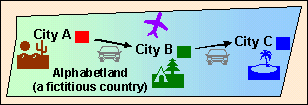
The Three Cities: Imagine that you are in a country called Alphabetland, and that you left City A in your car, drove through City B, and arrived in City C, your final destination. City A is in the plains; City B is near the mountains; City C is by the ocean. After your trip, you talked to your friends on the telephone and told them all about your journey.
-
Would you tell them that City C had beautiful plains and grasslands, even though those are really qualities of City A?
-
Would you tell your friends that City C had beautiful forests, mountains, and streams, even though those are descriptions of City B?
-
No. When you told them about City C, you would tell them only about the beautiful beaches and ocean, which are a part of the nature of City C. Surely, you would tell them about the other cities along the way, but you would not confuse the destination with the cities and scenery you encountered along the journey. You would not attribute the qualities and experiences of Cities A and B to City C.
Discriminate between journey and destination: Like confusing the cities along the way with the destination, it is very common for people to comment or ask questions about Yoga Nidra, yet actually be talking about experiences of the Waking state or the Dreaming state (Waking is like City A; Dreaming is like City B; Deep Sleep is like City C). While the contents, experiences and activities of the Waking state of reality and the Dreaming (or subtle) state are explored through Meditation, the exploration of these two states or levels is not the subject of conscious Deep Sleep (Prajna), or Yoga Nidra.
It is very useful for the practitioner of Meditation and Yoga Nidra to be aware of these differences. As noted near the beginning of this article, Meditation and Yoga Nidra are companion practices. Yogic practices with Waking, Dreaming, and Deep Sleep are surely complementary, but they are different from one another.
See also these articles on the Levels of Consciousness:
OM and the Seven Levels of Consciousness
4 Levels and 3 Domains of Consciousness
Mandukya Upanishad
Practices with active and latent impressions: To know that there are multiple levels or layers will help a great deal with Yogic practices. One of the main reasons this is important, is that it leaves us two general ways to work with practices. One way is to work with the processing, active images and impressions (again, whether in Waking or Dreaming). The other way is to work with the impressions in their latent, formless form, and this, like it or not, is another level of reality, which is underneath both the Waking and Dreaming states. It is the level at which the samskaras, the driving force behind karma, are stored.
Meditation in action (or mindfulness, if you prefer) and seated Meditation that explores Waking and Dreaming (subtle) both deal with the levels of active images and impressions (until it expands into deep Meditation or samadhi). Yoga Nidra works directly with the latent level of consciousness that is related with the Deep Sleep level. Once again, names of these levels and practices do not matter nearly as much as understanding that the active and latent aspects are there--working with them both, in their own ways, is extremely useful to the path of Self-realization.
Fourth vantage point: In our metaphor of the country called Alphabetland, we should also point out that there is another vantage point, and this is from a high flying airplane. From that higher place, one can look down and see all three cities (it's a rather small metaphorical country). This is somewhat like the fourth state of consciousness called Turiya, which refers to the pure consciousness permeating the other three. (Refer to the Turiya sections of the articles on OM Mantra and the Levels of Consciousness)
Do names really matter?: In some sense, none of these names really matter. Does it matter whether we call it Meditation or Yoga Nidra? Does it matter whether we say the Dreams and the subtle realm are in Taijasa, or that Deep Sleep has to do with the Prajna level?
What does matter very much, is that we remember that we are not just talking about two levels of consciousness (seen and unseen, worldly and spiritual, here and there, etc.). We are not just talking about one, single level of consciousness that is beyond our typical, Waking, day-to-day awareness. Rathere, there are two major levels of consciousness (or reality, or whatever we want to call it) beyond our typical, daily awareness.
This makes a total of three levels of consciousness (the "fourth" is of course beyond all of these). One of those major levels has to do with latent impressions, which are not presently acting out in form (whether in Waking or Dreaming), and the other does have to do with that active playing out of activities or thoughts (again, whether in Waking or Dreaming). (This multi-leveled process is also discussed in the article, Realization Beyond the Gross and Subtle.)
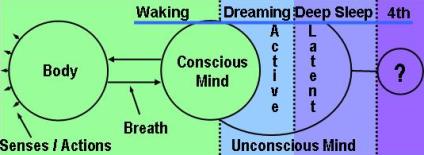
top
Yoga Nidra and the chakras
Chakras: The three states of consciousness are Waking, Dreaming, and Deep Sleep (Prajna), and these predominantly operate from three separate chakras. It is relatively easy to note that our Waking state operates from the area of the Ajna chakra. Simply notice that it is this area of the face from which we think, see, hear, and smell, etc., when we are in the Waking state. At other times, in our language, we refer to falling asleep into those lower chakras, as we enter Dreaming and Deep Sleep.
| State of Consciousness | Dominant Chakra |
| Waking | Ajna / eyebrow |
| Dreaming | Vishuddha / throat |
| Deep Sleep | Anahata / heart |
Heart chakra and emptying: Yoga Nidra is practiced by emptying into the space between the breasts, the heart chakra.
-
In the Waking state, consciousness operates from the eyebrow center, as the command center for mental and sensory process.
-
In the Dreaming state, the throat center is the place from which consciousness operates (note that the throat chakra is often described as a creative center, and that creativity is manifested, in part, as dream sequences).
-
In the Deep Sleep state, awareness automatically operates from the space between the breasts, the heart center.
Moving attention through three centers: Thus, in the practice of Yoga Nidra, one of the very effective parts of the process is to bring attention systematically through the levels of Waking and Dreaming, to the level of conscious Deep Sleep (Prajna) by moving attention through those three centers (described later in the Methods part of this paper):
| Systematic Inward Process to Yoga Nidra: |
| Waking > Dreaming > Conscious Deep Sleep |
| Eyebrow center > Throat > Space between Breasts |
Empty into the heart center: It is important to note that the question of chakra for Yoga Nidra is an entirely different question of which center on which one focuses for Meditation. One's predisposition at a personality level may be, for example, on feelings in the heart or thoughts in the eyebrow center. For Meditation, one may follow that predisposition as the space for focus. However, at the depth of the three levels of consciousness themselves, all people are constructed the same way, and thus the space between the breasts is the space for emptying into Yoga Nidra. It is the natural place where consciousness rests during Deep Sleep. It is also worthy of note that, from whatever chakra one might be practicing Meditation, there may come a moment, in a flash, that attention enters the subtle channel called brahma nadi, which goes between the eyebrow center inward and upward towards the crown chakra. This is sometimes mentioned in relation to a person seeing light at the end of a tunnel. This process need not be confused with questions of ones predispositions for Meditation, nor for emptying into the heart for Yoga Nidra.
top
Tantra and the three levels
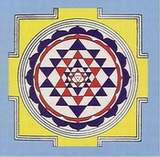 Tripura: Tri means three,
and pura means city. Tripura is the consciousness
that operates in the three cities of Waking, Dreaming, and Deep
Sleep, as well as the Conscious, Unconscious, and Subconscious aspects
of mind. Sometimes conceptualized as the divine feminine (Shakti),
compared to the divine masculine (Shiva), she permeates the three
cities of the Gross world, the Subtle plane, and the Causal
reality. Tripura also permeates the many other trinities such
as the beingness inherent in past, present and future. This is a
Tantric rendering of the three levels of consciousness mapped out by
the OM Mantra symbol, and its levels of Vaishvanara, Taijasa, and
Prajna. Dedication, devotion, love, and surrender into this creative
source or divine Mother is one of the finest aspects of Tantra as a
direct route to Realization. Some conceptualize Tripura as an
anthropomorphic deity, while the subtler practices are directed
towards Tripura as formless, that fourth state beyond
the other three cities. The Bindu of Sri Yantra is the
symbol of this highest transcendent Reality. The quality of the three
cities is an aspect of
Tripura: Tri means three,
and pura means city. Tripura is the consciousness
that operates in the three cities of Waking, Dreaming, and Deep
Sleep, as well as the Conscious, Unconscious, and Subconscious aspects
of mind. Sometimes conceptualized as the divine feminine (Shakti),
compared to the divine masculine (Shiva), she permeates the three
cities of the Gross world, the Subtle plane, and the Causal
reality. Tripura also permeates the many other trinities such
as the beingness inherent in past, present and future. This is a
Tantric rendering of the three levels of consciousness mapped out by
the OM Mantra symbol, and its levels of Vaishvanara, Taijasa, and
Prajna. Dedication, devotion, love, and surrender into this creative
source or divine Mother is one of the finest aspects of Tantra as a
direct route to Realization. Some conceptualize Tripura as an
anthropomorphic deity, while the subtler practices are directed
towards Tripura as formless, that fourth state beyond
the other three cities. The Bindu of Sri Yantra is the
symbol of this highest transcendent Reality. The quality of the three
cities is an aspect of
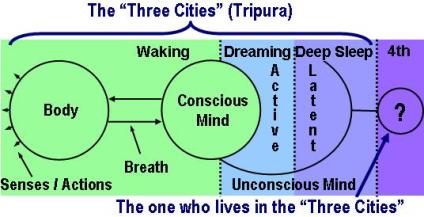
See also the articles:
Kundalini Awakening
Three Schools of Tantra
Bindu
top
The methods are many, and simple
From gross to subtle: There are many methods leading up to the point where you can jump off into the state of Yoga Nidra. The idea of working with those preparatory methods is that you start with your attention on the gross aspects of you being, such as the physical body, then systematically move awareness inward to the subtler levels.
Progressive inner attention: For example, moving breath awareness up and down the stream of light in the spine is subtler, deeper, more interior than moving inner awareness through the physical parts of the body. Progressively, attention goes inward to that final, inner place of jumping off into the stillness and silence of Yoga Nidra.
Many ways: So, for example, how many ways can you move awareness through the physical body? Many! How many ways can you work with breath awareness? Many! How many ways can you explore the subtler energy flows? Many!
|
Yoga Nidra is a state of consciousness, |
State versus methods: The point, once again, is that while the various methods are extremely useful in leading awareness subtler and subtler, Yoga Nidra itself is a state of consciousness, not the methods that lead you to that state. Yoga Nidra is a state of conscious Deep Sleep (Prajna).
Simple methods lead to emptying: Each of the various methods are also pretty simple, in that they all involve the straightforward shifting of attention here and there, in ever subtler ways. The difficulty, if it can be called a difficulty, is in the act of letting go itself, of the determined, willful emptying that leads to Yoga Nidra. But that too comes with practice.
Universal: It is important to once again note that the state of Yoga Nidra is universal, regardless of whether or not one has ever heard of it as the name Yoga Nidra. Yoga Nidra, as such, has been known to the yogis for thousands of years, while some reports incorrectly claim that Yoga Nidra was invented in the past few decades by a single modern teacher.
top
Yoga Nidra Methods of practice
Methods: Following are outlines and links to several methods of entering Yoga Nidra. The details of the practices are on individual web pages so that these can be printed out for easier review and practice. The lengths of the practices might vary from as little as 10-20 minutes, or as much as 50-60 minutes or more.
|
Yoga Nidra is a state of consciousness, |
The state comes after the methods: As you review these methods and practice them, remember that Yoga Nidra is the state of conscious Deep Sleep (Prajna) that comes after, or as a result of the methods, by emptying the content of images and impressions. Also, there is a guided Yoga Nidra CD available that is similar to Method #2. Or, you might wish to use your own recorder to make a guided practice in your own voice.
| Method: | Involves these practices: |
| Method #1 |
|
| Method #2 |
|
| Method #3 |
|
| Method #4 | |
| Method #5 |
|
top
Yoga Nidra begins
to come naturally
It starts to come naturally: When ones whole life becomes one of Meditation, Yoga Nidra begins to come naturally. The nature of daily sleep begins to change. It becomes more conscious when one wants it to be so. Dreams are seen more vividly, and there is often a natural sense of lying in bed sleeping, while still being awake. Awareness more easily goes to the stillness and silence beyond those dreams, into conscious Deep Sleep.
Witnessing and determination: How does this happen, that Yoga Nidra comes naturally? As you gradually gain more and more of a witnessing stance about everything external and internal, it becomes easier to set aside mental content with a simple act of determination, sankalpa shakti. In a sense, you simply go there, emptying and entering Yoga Nidra.
See also the
article:
Bindu: Pinnacle of Yoga, Vedanta and Tantra
Yoga Nidra and Mandukya Upanishad
The pinnacle of the wisdom of the ancient sages is contained in the terse twelve verses of the Mandukya Upanishad, which outlines the philosophy and practices of the OM mantra. It has been said that the juice of the Vedas is in the Upanishads, and the juice of the Upanishads is in the Mandukya Upanishad.
Third level relates to Yoga Nidra: The third of the four levels of consciousness mapped out in the Mandukya Upanishad is called Prajna, which is the level of Deep Sleep. This is the domain of Yoga Nidra, which is conscious Deep Sleep.
See also these articles on the Levels of Consciousness:
OM and the Seven Levels of Consciousness
4 Levels and 3 Domains of Consciousness
Mandukya Upanishad
Verses
1-2 describe the Self and the Absolute.
Verses 3-7 explain the four levels of consciousness.
Verses 8-12 outline the four aspects of AUM.
The Self and the Absolute (1-2):
1) All is OM: Hari Om. The whole universe is the syllable Om. Following is the
exposition of Om. Everything that was, is, or will be is, in truth Om.
All else which transcends time, space, and causation is also Om.
2) Atman has Four Aspects: All of this, everywhere, is in truth Brahman, the Absolute Reality.
This very Self itself, Atman, is also Brahman, the Absolute Reality.
This Atman or Self has four aspects through which it operates. Four
Levels of Consciousness (3-7):
3) First is Waking / Gross: The first aspect of Atman is the Self in the Waking state, Vaishvanara. In this first state, consciousness is turned outward to the external world. Through its seven instruments and nineteen channels, it experiences the gross objects of the phenomenal world.
4) Second is Dreaming / Subtle: The second aspect of Atman is the Self in the Dreaming state, Taijasa. In this second state, consciousness is turned towards the inner world. It also operates through seven instruments and nineteen channels, which engage the subtle objects of the mental realm.
5) Third is Deep Sleep /
Causal: The third aspect of Atman is the Self operating in the Deep
Sleep state, Prajna. In this third state, there is neither the desire
for any gross or subtle object, nor any dream sequences. In Deep Sleep,
all such experiences have receded or merged into the ground of
undifferentiated consciousness. Here, one is filled with the experience
of bliss, and can also find the way to clearer knowledge of the two preceding states.
(This is the domain of Yoga Nidra, conscious Deep Sleep.)
Yoga Nidra - Conscious Deep Sleep:
6) Find the Experiencer: The one who experiences all of these states of consciousness is the omniscient, indwelling source and director of all. This one is the womb out of which all of the other emerge. All things originate from and dissolve back into this source.
7) The Fourth Aspect is Turiya: The fourth aspect of Atman or Self is Turiya, literally the fourth. In this fourth state, consciousness is neither turned outward nor inward. Nor is it both outward and inward; it is beyond both cognition and the absence of cognition. This fourth state of Turiya cannot be experienced through the senses or known by comparison, deductive reasoning or inference; it is indescribable, incomprehensible, and unthinkable with the mind. This is Pure Consciousness itself. This is the real Self. It is within the cessation of all phenomena. It is serene, tranquil, filled with bliss, and is one without second. This is the real or true Self that is to be realized.
Four Aspects of AUM (8-12):
8) Those Four are the Same with "A-U-M" and Silence: That Om, though described as having four states, is indivisible; it is pure Consciousness itself. That Consciousness is Om. The three sounds A-U-M (ah, ou, mm) and the three letters A, U, M are identical with the three states of Waking, Dreaming, and sleeping, and these three states are identical with the three sounds and letters. The fourth state, Turiya is to be realized only in the silence behind or beyond the other three.
9) The Sound "A" is Waking / Gross: Vaishvanara is the consciousness experienced during the Waking state, and is A, the first letter of Om. That simple sound of A is first and permeates all other sounds. One who is aware of this first level of reality has fulfillment of all longings and is successful.
10) The Sound "U" is Dreaming / Subtle: Taijasa is the consciousness experienced during the Dreaming state, and is U, the second letter of Om. This intermediate state operates between the Waking and sleeping states, reflecting some qualities of the other two. One who knows this subtler state is superior to others. For one who knows this, knowers of Brahman, the Absolute Reality, will be born into his family.
11) The Sound "M" is Deep
Sleep / Causal: Prajna is the consciousness experienced during the
state of dreamless, Deep Sleep, and is M, the third letter of Om.
It contains the other two, and is that from which the other two emerge,
and into they recede or merge. A knower of this more subtle state can
understand all within himself.
(This is the domain of Yoga Nidra, conscious Deep Sleep.)
Yoga Nidra - Conscious Deep Sleep:
Silence after "A-U-M" is the True Self: The fourth aspect is the soundless aspect of Om. It is not utterable and is not comprehended through the senses or by the mind. With the cessation of all phenomena, even of bliss, this soundless aspect becomes known. It is a state of nondual (advaita) realityone without a second. This fourth state, Turiya, is the real Self or true Self. One with direct experience of this expands to Universal Consciousness.
-------
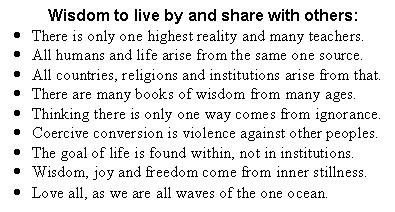
Other yoga nidra links: Amazon, Barnes and Noble, Holistic online, Life positive, Neovedanta, Scandanavian yoga, Yoga for dummies, Muz Murray, Yogapoint, Yogamag, Health and yoga, Cancer hope, Whole life, Yoga.com, Amrit yoga, Best web, Positivepath, Saraswati yoga

-------
This site is devoted to presenting the ancient Self-Realization path of the Tradition of the Himalayan masters in simple, understandable and beneficial ways, while not compromising quality or depth. The goal of our sadhana or practices is the highest Joy that comes from the Realization in direct experience of the center of consciousness, the Self, the Atman or Purusha, which is one and the same with the Absolute Reality. This Self-Realization comes through Yoga meditation of the Yoga Sutras, the contemplative insight of Advaita Vedanta, and the intense devotion of Samaya Sri Vidya Tantra, the three of which complement one another like fingers on a hand. We employ the classical approaches of Raja, Jnana, Karma, and Bhakti Yoga, as well as Hatha, Kriya, Kundalini, Laya, Mantra, Nada, Siddha, and Tantra Yoga. Meditation, contemplation, mantra and prayer finally converge into a unified force directed towards the final stage, piercing the pearl of wisdom called bindu, leading to the Absolute.
Yoga Nidra means yogic sleep, a state of conscious deep sleep for extreme relaxation and subtler spiritual exploration.
Basic Yoga Meditation CD and Yoga Nidra Meditation CD
Two CDs include four traditional guided Yoga meditation practices of 3, 7, 11, and 30 minutes, as well as the extremely popular Yoga Nidra Meditation CD by Swami
Yoga nidra - Wikipedia, the free encyclopedia
Yoga nidra or "yogic sleep" is a sleep-like state which yogis report to experience during their meditations. Yoga nidra, lucid sleeping is among the deepest possible
Yoga Nidra Meditation: Extreme Relaxation of Conscious ...
Yoga Nidra Meditation: Extreme Relaxation of Conscious Deep Sleep by Cd Baby, Swami Jnaneshvara Bharati "Swami J". Skip to Main Content; Sign in. My Account.
Sleep and Yoga Nidra - Yoga Magazine - Magazine of the ...
Sleep and Yoga Nidra Dr. Swami Karmananda Saraswati MB, BS (Syd) Sleep is a natural, regularly occurring condition of generalised rest and relaxation of the mind
Yoga Nidra Meditation: Extreme Relaxation of Conscious ...
Find album reviews, stream songs, credits and award information for Yoga Nidra Meditation: Extreme Relaxation of Conscious Deep Sleep - Swami Jnaneshvara Bharati
Yoga Nidra Meditation CD | Facebook
Yoga Nidra Meditation CD. 2,154 likes · 5 talking about this. This has been the most popular Yoga Nidra CD in the world for ten years. This CD is for
Amazon.com: Yoga Nidra Meditation: Extreme Relaxation of ...
Amazon.com: Yoga Nidra Meditation: Extreme Relaxation of Conscious Deep Sleep: Swami Jnaneshvara Bharati: MP3 Downloads
Swami Jnaneshvara Bharati | Yoga Nidra Meditation: Extreme ...
This meditation is an authentic rendering of Yoga Nidra as taught in the Himalayas by the Tantra and Yoga masters. While it is an advanced meditation practice, anyone
Yoga Nidra - Swami Satyananda Saraswati - Google Books
Yoga Nidra, which is derived from the tantras, is a powerful technique in which you learn to relax consciously. In yoga nidra, sleep is not regarded as relaxation.
